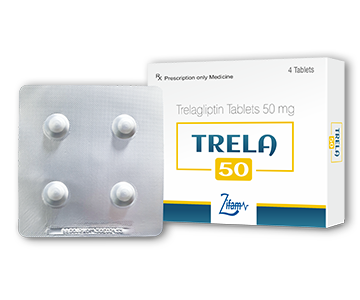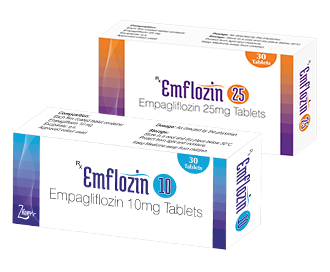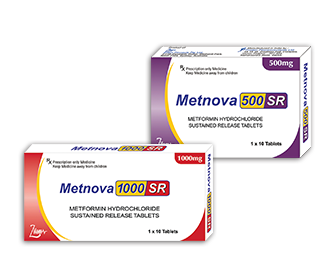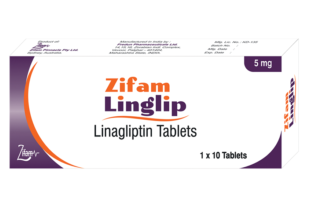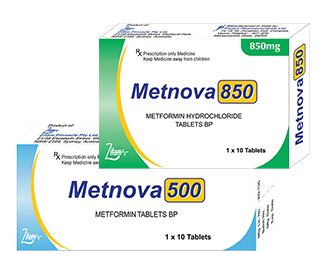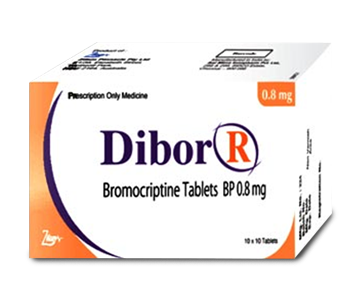Ziglip 50/100
- ENG
- မြန်မာ
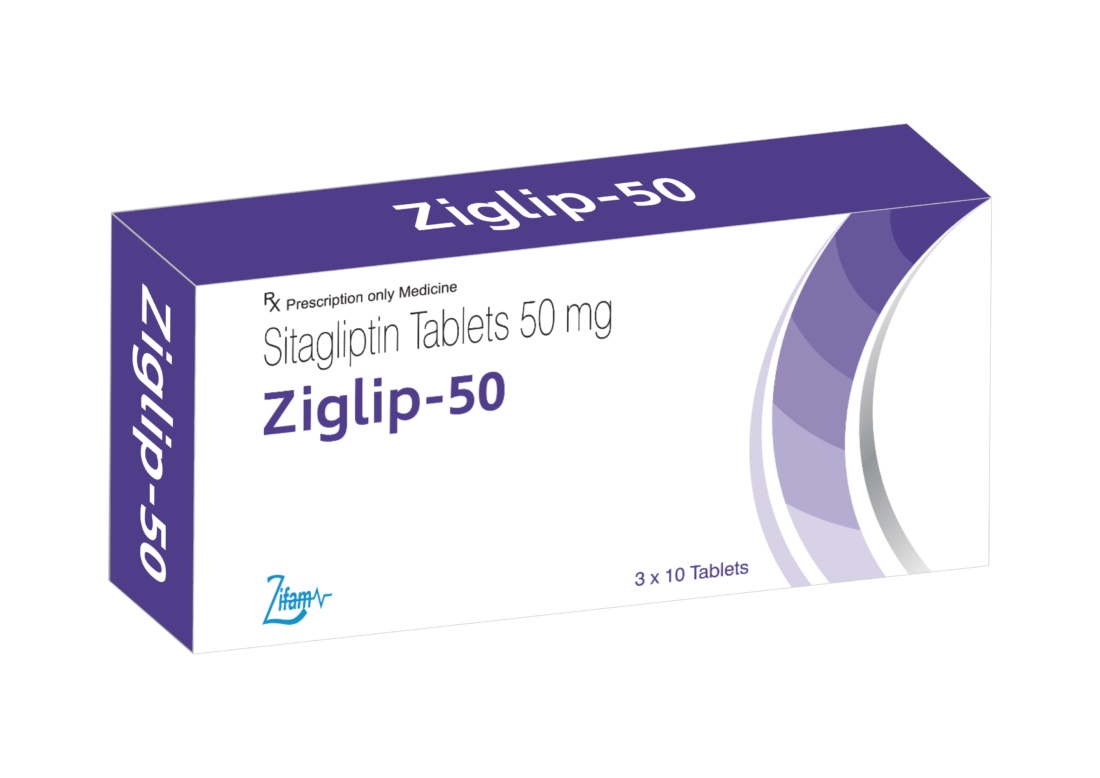
Sitagliptin Tablets 50mg
COMPOSITION:
Each Film-Coated Tablet Contains:
Sitagliptin Phosphate
Monohydrate…………………………………64.25mg
Equivalent to Sitagliptin………………..50 mg
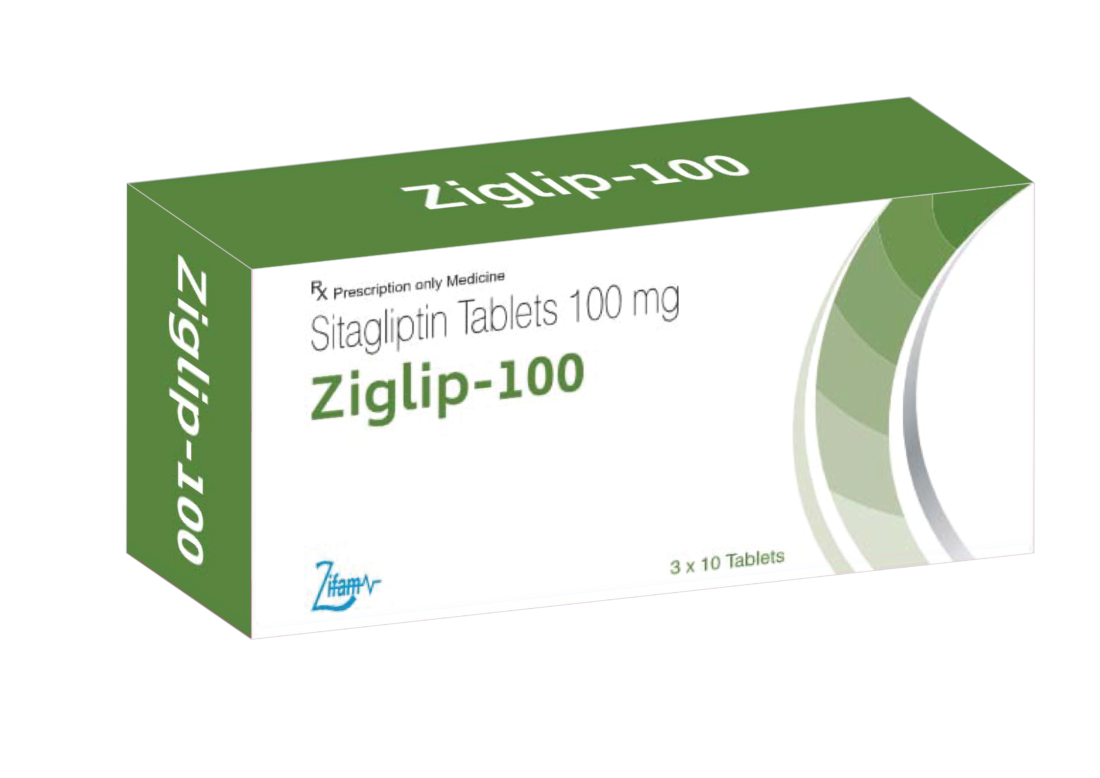
Sitagliptin Talbets 100mg
COMPOSITION:
Each Film-Coated Tablet Contains:
Sitagliptin Phosphate
Monohydrate………………………………..128.50 mg
Equivalent to Sitagliptin……………….100 mg
DESCRIPTION
Ziglip-50 / Ziglip -100 Tablets contain sitagliptin phosphate, an orally-active inhibitor of the dipeptidyl peptidase- 4 (DPP-4) enzyme.
Sitagliptin phosphate monohydrate is described chemically as 7-[(3R)-3-amino-1-oxo-4-2,4,5-trifluorophenyl) butyl]-5,6,7,8-tetrahydro-3-(trifluoromethyl)-1,2,4-triazolo[4,3-alpyrazine phosphate (1:1) monohydrate.
The empirical formula is C16H15F6N5OH3PO4H20 and the molecular weight is 523.32 Sitagliptin phosphate monohydrate is a white to off-white, crystalline, non-hygroscopic powder. It is soluble in water and N,N-dimethyl formamide; slightly soluble in methanol; very slightly soluble in ethanol, acetone, and acetonitrile; and insoluble in isopropanol and isopropyl acetate.
Each film-coated tablet of Ziglip – 50 / Ziglip – 100 contains 64.25 or 128.5 mg of Sitagliptin Phosphate Monohydrate, which is equivalent to 50 or 100 mg, respectively.
Ziglip – 50 (Sitagliptin Tablets 50 mg) are white coloured circular, biconvex, film coated tablets with scoring on one side and plain on other side.
Ziglip -100 (Sitagliptin Tablets 100 mg) are blue coloured, film coated caplets with scoring on one side and plain on other side.
INDICATIONS AND USAGE
Monotherapy and Combination Therapy
Ziglip – 50/ Ziglip – 100 is indicated as an adjunct to diet and exercise to improve glycemic control in aduits with type 2 diabetes mellitus.
Important Limitations of Use
Ziglip – 50/ Ziglip – 100 should not be used in patients with type 1 diabetes or for the treatment of diabetic ketoacidosis, as it would not be effective in these settings.
Ziglip – 50/ Ziglip – 100 has not been studied in patients with a history of pancreatitis. It is unknown whether patients with a history of pancreatitis are at increased risk for the development of pancreatitis while using Ziglip – 50 / Ziglip – 100.
DOSAGE AND ADMINISTRATION
Recommended Dosing
The recommended dose for Ziglip – 50 is two tablets a day and the recommended dose for Ziglip 100 is one tablet a day. Ziglip – 50 / Ziglip – 100 can be taken with or without food.
Patients with Renal Insufficiency
For patients with mild renal insufficiency (creatinine clearance [CrCI] greater than or equal to 50 mL/min, approximately corresponding to serum creatinine levels of less than or equal to 1.7 mg/dL in men and less than or equal to 1.5 mg/dL in women), no dosage adjustment for Ziglip – 50 / Ziglip – 100 is required.
For patients with moderate renal insufficiency (CrCl greater than or equal to 30 to less than 50 mL/min, approximately corresponding to serum creatinine levels of greater than 1.7 to less than or equal to 3.0 mg/dLin men and greater than 1.5 to less than or equal to 2.5 mg/dL in women), the dose of Ziglip – 50 / Ziglip – 100 is 50 mg once daily.
For patients with severe renal insufficiency (CrCH less than 30 mL/min, approximately corresponding to serum creatinine levels of greater than 3.0 mg/dL in men and greater than 2.5 mg/dL in women) or with end-stage renal disease (ESRD) requiring hemodialysis or peritoneal dialysis, the dose of Ziglip – 50 / Ziglip – 100 is 25 mg once daily. Ziglip – 50/ Ziglip – 100 may be administered without regard to the timing of dialysis.
Because there is a need for dosage adjustment based upon renal function, assessment of renal function is recommended prior to initiation of Ziglip – 50 / Ziglip – 100 and periodically thereafter.
There have been postmarketing reports of worsening renal function in patients with renal insufficiency, some of whom were prescribed inappropriate doses of Sitagliptin.
Concomitant Use with an Insulin Secretagogue (e.g., Sulfonylurea) or with Insulin
When Ziglip – 50 / Ziglip – 100 is used in combination with an insulin secretagogue (e.g., sulfonylurea) or with insulin, a lower dose of the insulin secretagogue or insulin may be required to reduce the risk of hypoglycemia.
CONTRAINDICATIONS
History of a serious hypersensitivity reaction to Sitagliptin, such as anaphylaxis or angioedema.
WARNINGS AND PRECAUTIONS
Pancreatitis
There have been postmarketing reports of acute pancreatitis, including fatal and non-fatal hemorrhagic or necrotizing pancreatitis, in patients taking Sitagliptin. After initiation of Sitagliptin, patients should be observed carefully for signs and symptoms of pancreatitis. If pancreatitis is suspected, Sitagliptin should promptly be discontinued and appropriate management should be initiated. It is unknown whether patients with a history of pancreatitis are at increased risk for the development of pancreatitis while using Sitagliptin.
Renal Impairment
Assessment of renal function is recommended prior to initiating Sitagliptin and periodically thereafter. A dosage adjustment is recommended in patients with moderate or severe renal insufficiency and in patients with ESRD requiring hemodialysis or peritoneal dialysis.
Caution should be used to ensure that the correct dose of Sitagliptin is prescribed for patients with moderate (creatinine clearance 30 to <50 mL/min) or severe (creatinine clearance <30 mL/min) renal impairment.
There have been postmarketing reports of worsening renal function, including acute renal failure, sometimes requiring dialysis. A subset of these reports involved patients with renal insufficiency, some of whom were prescribed inappropriate doses of Sitagliptin. A return to baseline levels of renal insufficiency has been observed with supportive treatment and discontinuation of potentially causative agents.
Consideration can be given to cautiously reinitiating Sitagliptin if another etiology is deemed likely to have precipitated the acute worsening of renal function.
Sitagliptin has not been found to be nephrotoxic in preclinical studies at clinically relevant doses, or in clinical trials.
Use with Medications Known to Cause Hypoglycemia
When Sitagliptin was used in combination with a sulfonylurea or with insulin, medications known to cause hypoglycemia, the incidence of hypoglycemia was increased over that of placebo used in combination with a sulfonylurea or with insulin. Therefore, a lower dose of sulfonylurea or insulin may be required to reduce the risk of hypoglycemia.
Hypersensitivity Reactions
There have been postmarketing reports of serious hypersensitivity reactions in patients treated with Sitagliptin. These reactions include anaphylaxis, angioedema, and exfoliative skin conditions including Stevens-Johnson syndrome. Onset of these reactions occurred within the first 3 months after initiation of treatment with Sitagliptin, with some reports occurring after the first dose. If a hypersensitivity reaction is suspected, discontinue Sitaliptin, assess for other potential causes for the event, and institute alternative treatment for diabetes.
Angiodma has also been reported with other dipeptidyl peptidase-4 (DP-4) inhibitors, Use caution in a patient with a history of angioedema with another DP-4 inhibitor because it is unknown whether such patients will be predisposed to angioedema with Sitagliptin.
Severe and Disabling Arthralgia
There have been postmarketing reports of severe and disabling arthralgia in patients taking PA inhibitors. The time to onset of symptoms following initiation of drug therapy varied from one dayto years. Patients experienced relie of symptoms upon discontinuation of the medication, A subset of patients experienced a recurrence of symptoms when restarting the same drug or a different DPP-4 inhibitor. Consider DPP-4 inhibitors as a possible cause for severe joint pain and discontinue drug if appropriate.
Macrovascular Outcomes
There have been no cinical studies estabishing concusive evidence of macrovascularisk reduction with Siaglipin orany other anti-diabetic drug.
ADVERSE REACTIONS
Clinical Trials Experience
Because clinical trials are conducted under widely varying conditions, adverse reaction rates observed in the clinical trials of a drug cannot be directly compared to rates in the clinical trials of another drug and may not reflect the rates observed in practice.
In controlled clinical studies as both monotherapy and combination therapy with metformin, poglitazone, or rosiglitazone and metformin, the overall incidence of adverse reactions, hypoglycemia, and discontinuation of therapy due to clinical adverse reactions with Sitagliptin were similar to placebo. In combination with glimepiride, with or without metformin, the overall incidence of clinical adverse reactions with Sitagliptin was higher than with placebo, in part related to a higher incidence of hypoglycemia the incidence of discontinuation due to clinical adverse reactions was similar to placebo.
Two placebo-controlled monotherapy studies, one of 18- and one of 24-week duration, included patients treated with Sitagliptin daily and placebo. Five placebo- controlled add-on combination therapy studies were also conducted: one with metformin; one with pioglitazone; one with metformin and rosglitazone; one with glimepiride (with or without metformin); and one with insulin (with or without metformin). In these trials, patients with inadequate glycemic control on a stable dose of the background therapy were randomized to add-on therapy with Sitagliptin daily or placebo. The adverse reactions, excluding hypoglycemia, reported regardless of investigator assessment of causality in 5% of patients treated with Sitagliptin daily and more commonly than in patients treated with placebo for the clinical trials of atleast 18 weeks duration.
Laboratory Tests
Across clinical studies, the incidence of laboratory adverse reactions was similar in patients treated with Sitagliptin compared to patients treated with placebo. A small increase in white blood cell count (WBC) was observed due to an increase in neutrophils. This increase in WBC (of approximately 200 cells/microL vs placebo, in four pooled placebo-controlled clinical studies, with a mean baseline WBC count of approximately 6600 cells/microL) is not considered to be clinically relevant. In a 12-week study of 91 patients with chronic renal insufficiency, 37 patients with moderate renal insufficiency were randomized to Sitaliptin daily, while 14 patients with the same magnitude of renal impairment were randomized to placebo. Mean (SE) increases in serum creatinine were observed in patients treated with Sitagliptin [0.12 mg/dL (0.04)] and in patients treated with placebo [0.07 mg/dL (0.07)]. The clinical significance of this added increase in serum creatinine relative to placebo is not known.
Postmarketing Experience
Additional adverse reactions have been identified during postapproval use of Sitagliptin as monotherapy and/or in combination with other antihyperglycemic agents. Because these reactions are reported voluntarily from a population of uncertain size, it is generally not possible to reliably estimate their frequency or establish a causal relationship to drug exposure.
Hypersensitivity reactions including anaphylaxis, angioedema, rash, urticaria, cutaneous vasculitis, and exfoliative skin conditions including Stevens-Johnson syndrome; hepatic enzyme elevations; acute pancreatitis, including fatal and non-fatal hemorrhagic and necrotizing; worsening renal function, including acute renal failure; severe and disabling arthralgia; constipation; vomiting; headache; myalgia; pain in extremity; back pain; pruritus.
DRUG INTERACTIONS
Digoxin
There was a slight increase in the area under the curve (AUC, 11%) and mean peak drug concentration (Cmax, 18%) of digoxin with the co-administration of 100 mg sitagliptin for 10 days. Patients receiving digoxin should be monitored appropriately. No dosage adjustment of digoxin or Sitagliptin is recommended.
USE IN SPECIFIC POPULATIONS
Pregnancy
Reproduction studies have been performed in rats and rabbits. Doses of sitagliptin up to 125 mg/kg (approximately 12 times the human exposure at the maximum recommended human dose) did not impair fertility or harm the fetus. There are, however, no adequate and well-controlled studies in pregnant women. Because animal reproduction studies are not always predictive of human response, this drug should be used during pregnancy only if clearly needed.
Sitagliptin administered to pregnant female rats and rabbits from gestation day 6 to 20 (organogenesis) was not teratogenic at oral doses up to 250 mg/kg (rats) and 125 mg/kg (rabbits), or approximately 30- and 20-times human exposure at the maximum recommended human dose (MRHD) of 100 mg/day based on AUC comparisons. Higher doses increased the incidence of rib malformations in offspring at 1000 mg/kg, or approximately 100 times human exposure at the MRHD.
Sitagliptin administered to female rats from gestation day 6 to lactation day 21 decreased body weight in male and female offspring at 1000 mg/kg. No functional or behavioral toxicity was observed in offspring of rats.
Placental transfer of sitagliptin administered to pregnant rats was approximately 45% at 2 hours and 80% at 24 hours postdose. Placental transfer of sitagliptin administered to pregnant rabbits was approximately 66% at 2 hours and 30% at 24 hours.
Nursing Mothers
Silagliptin is secreted in the milk of lactating rats at a milk to plasma ratio of 4:1. It is not known whether sitagliptin is excreted in human milk. Because many drugs are excreted in human milk, caution should be exercised when Sitagliptin is administered to a nursing woman.
Pediatric Use
Safety and effectiveness of Sitagliptin in pediatric patients under 18 years of age have not been established.
Geriatric Use
Of the total number of subjects (N=3884) in pre-approval linical safety and efficacy studies of Stagliptin, 725 patients were 65 years and over, while 61 patients were 75 years and over. No overall differences in safety or effectiveness were observed between subjects 65 years and over and younger subjects. While this and other reported clinical experience have not identified differences in responses between the elderly and younger patients, greater sensitivity of some older individuals cannot be ruled out.
This drug is known to be substantially excreted by the kidney. Because elderly patients are more likely to have decreased renal function, care should be taken in dose selection in the elderly, and it may be useful to assess renal function in these patients prior to initiating dosing and periodically thereafter.
OVERDOSAGE
During controlled clinical trials in healthy subjects, single doses of up to 800 mg Sitagliptin were administered. Maximal mean increases in QTc of 8.0 msec were observed in one study at a dose of 800 mg Sitagliptin, a mean effect that is not considered clinically important. There is no experience with doses above 800 mg in clinical studies. In Phase I multiple-dose studies, there were no dose-related clinical adverse reactions observed with Sitagliptinwith doses of up to 600 mg per day for periods of up to 10 days and 400 mg per day for up to 28 days.
In the event of an overdose, is reasonable to employ the usual supportive measures, e.g, remove unabsorbed material from the gastrointestinal tract, employ clinical monitoring including obtaining an electrocardiogram), and institute supportive therapy as dictated by the patient’s clinical status.
Sitagliptin is modestly dialyzable. In clinical studies, approximately 13.5% of the dose was removed over a 3-to 4-hour hemodialysis session. Prolonged hemodialysis may be considered if clinically appropriate. Itis not known if sitagliptin is dialyzable by peritoneal dialysis.
CLINICAL PHARMACOLOGY
Mechanism of Action
Silagliptin is a DPP-4 inhibitor, which is believed to exert its actions in patients with type 2 diabetes by slowing the inactivation of incretin hormones. Concentrations of the active intact hormones are increased by Sitagliptin, thereby increasing and prolonging the action of these hormones.
Inerein homones induding glucagn-Ike pepuide-1 (LP-1) and gucose dpeneins are pat o polypepide (iP), are ralased by the intestine hroughout the day andleves are inceased inresponse to a
melies hom ines ding aucy nivated by the enzyme, DP-4. The inessland release of an endogenous system invared by the priestin gi regulation of glucose homeostasis. When blood glucose conal heations are normal rapidly id. aPe and CiP Increase insulin syntestion. yines from pancreatic bela cels by ita in lar signing pa reways involving cycic AMP. GLP. also lovers glucagon socionio arreal prelevaled, ding 1 reduced hepati glucosa productio. noreasin and prolonging active ince in evely salotin a ase insulin release and decreases glucagon levels in the
artinia guosa de pendentis ar Sia lip in demonstrates selectivily for DP 4 and does not hibit P 8 or D- activil s, a once trains approximating those from therapeutic doses.
Pharmacodynamics
In General
In patents wih type 2 diabetes. administrationof Staglipin led toinhibition of DPP4 enzyme activity for a 24-hour period. Aferan oralgucoseloadorameal, this DPP-4 inhibion resutedina 2-to 3-fold increase in circulating levels of active GLP-1 and GIP, decreased glucagon concentrations, and increased responsiveness of insulin release to gluose, resultang in higher C-peptide and insulin concentrations. The ise in insulin with the decrease in gucagon was associated with lower fasting glucose concentrations and reduced glucose excursion following an oral glucose load or a neal.
In a two-day study in healthy subjects, sitaliptin alone increased active GLP-1 concentralions, whereas metformin alone increased active and total GLP-1 concentralions to similar extents.
Co- administration of sitagliptin and metformin had an additive effect on active GLP-1 concentrations.
Sitagliptin, but not metformin, increased active GIP concentrations. Its unclear how these findings relate to changes in glycemic control in patients with type 2 diabetes.
In studies with healthy subjects, Sitagliptin did not lower blood glucose or cause hypoglycemia.
Pharmacokinetics
The pharmacokinetics of sitagliptin has been extensively characterized in healthy subjects and patients with type 2 diabetes. After oral administration of a 100 mg dose to healthy subjects, sitaliptin was rapidly absorbed, with peak plasma concentrations (median Tmax) occurring 1 to 4 hours post dose.
Plasma AUC of siagliptin increased in a dose-proportional manner. Following a single oral 100 mg dose to healthy volunteers, mean plasma AUC of sitagliptin was 8.52, Cmax was 950 nM, and apparent terminal half-life (1/2) was 12.4 hours. Plasma AUC of sitaliptin increased approximately 14% following 100 mg doses at steady-state compared to the first dose. The intra-subject and inter-subject coefficients of variation for sitagliptin AUC were small (5.8% and 15.1%). The pharmacokinetics of sitagliptin was generally similarin healthy subjects and in patients with type 2 diabetes.
Absorption
The absolute bioavailability of sitagliptin is approximately 87%. Because co-administration of a high-fat meal with Sitagliptin had no effect on the pharmacokinetics, Sitagliptin may be administered with or without food.
Distribution
The mean volume of distribution at steady state following a single 100 mg intravenous dose of sitagliptin to healthy subjects is approximately 198 liters. The fraction of sitagliptin reversibly bound to plasma proteins is low (38%).
Metabolism
Approximately 79% of sitagliptin is excreted unchanged in the urine with metabolism being a minor pathway of elimination.
Following a [14C]sitagliptin oral dose, approximately 16% of the radioactivity was excreted as metabolites of sitagliptin. Six metabolites were detected at trace levels and are not expected to contribute to the plasma DPP-4 inhibitory activity of sitagliptin. In vitro studies indicated that the primary enzyme responsible for the limited metabolism of sitagliptin was CYP3A4, with contribution from CYP2C8.
Excretion
Following administration of an oral [14)sitagliptin dose to healthy subjects, approximately 100% of the administered radioactivity was eliminated in feces (13%) or urine (87%) within one week of dosing.
The apparent terminal t1/2 following a 100 mg oral dose of sitagliptin was approximately 12.4 hours and renal clearance was approximately 350 mL/min.
Elimination of sitagliptin occurs primarily via renal excretion and involves active tubular secretion.
Sitagliptin is a substrate for human organic anion transporter-3 (hOAT-3), which may be involved in the renal elimination of sitagliptin. The clinical relevance of hOAT-3 in sitagliptin transport has not been established.
Sitagliptin is also a substrate of p-glycoprotein, which may also be involved in mediating the renal elimination of sitagliptin. However, cyclosporine, a p-glycoprotein inhibitor, did not reduce the renal clearance of sitagliptin.
Special Populations
Renal Insufficiency
A single-dose, open-label study was conducted to evaluate the pharmacokinetics of Sitagliptin in patients with varying degrees of chronic renal insufficiency compared to normal healthy control subjects. The study included patients with renal insufficiency classified on the basis of creatinine clearance as mild (50 to <80 mL/min), moderate (30 to <50 mL/min), and severe (<30 mL/min), as well as patients with ESRD on hemodialysis. In addition, the effects of renal insufficiency on sitagliptin pharmacokinetics in patients with type 2 diabetes and mild or moderate renal insufficiency were assessed using population pharmacokinetic analyses.
Hepatic Insufficiency
In patients with moderate hepatic insufficiency (Child-Pugh score 7 to 9), mean AUC and Cmax of sitagliptin increased approximately 21% and 13%, respectively, compared to healthy matched controls following administration of a single 100 mg dose of Sitagliptin. These differences are not considered to be clinically meaningful. No dosage adjustment for Stagliptin is necessary for patients with mild or moderate hepatic insufficiency.
There is no clinical experience in patients with severe hepatic insufficiency (Child-Pugh score >9).
Body Mass Index (BMI)
No dosage adjustmentis necessary based on BMI. Body mass index had no clinically meaningful effect on the pharmacokinetics of sitagliptin based on a composite analysis of Phase I pharmacokinetic data and on a population pharmacokinetic analysis of Phase I and Phase I| data.
Gender
No dosage adjustment is necessary based on gender. Gender had no clinically meaningful effect on the pharmacokinetics of sitagliptin based on a composite analysis of Phase I pharmacokinetic data and on a population pharmacokinetic analysis of Phase I and Phase II data.
Geriatric
No dosage adjustment is required based solely on age. When the effects of age on renal function are taken into account, age alone did not have a clinically meaningful impact on the pharmacokinetics of stagliptin based on a population pharmacokinetic analysis. Elderly subjects (65 to 80 years) had approximately 19% higher plasma concentrations of sitagliptin compared to younger subjects.
Pediatric
Studies characterizing the pharmacokinetics of sitagliptin in pediatric patients have not been performed.
Race
No dosage adjustment is necessary based on race. Race had no clinically meaningful effect on the pharmacokinetics of sitaliptin based on a composite analysis of available pharmacokinetic data, including subjects of white, Hispanic, black, Asian, and other racial groups.
Drug Interactions
In Vitro Assessment of Drug Interactions
Sitagliptin is not an inhibitor of CYP isozymes CYP3A4, 2C8, 2C9, 2D6, 1A2, 2C19 or 26, and is not an inducer of CYP3A4. Sitagliptin is a p-glycoprotein substrate, but does not inhibit p-lycoprotein mediated transport of digoxin. Based on these results, sitagliptin is considered unlikely to cause interactions with other drugs that utilize these pathways.
Sitagliptin is not extensively bound to plasma proteins. Therefore, the propensity of sitagliptin to be involved in clinically meaningful drug-drug interactions mediated by plasma protein binding displacement is very low.
In Vivo Assessment of Drug Interactions
Effects of Sitagliptin on Other Drugs
In clinical studies, as described below, sitagliptin did not meaningfully alter the pharmacokinetics of metformin, glyburide, simvastatin, rosiglitazone, warfarin, or oral contraceptives, providing in vivo evidence of a low propensity for causing drug interactions with substrates of CYP3A4, CYP2C8, CYP 2C9, and organic cationic transporter (OCT).
Digoxin: Sitaglipin had a minimal fecton the pharmacokinetics ofdigoxin, Following administration of 0.25 mg digoxin Concomitanty with 100 mg of Zigip-50 /Zigip 100 dailyfor 10 days, the plasma AUC of digoxin was increased by 11%, and the plasma Cmax by 18%.
Metformin: Co-administration of mutiple twice-daily doses of sitagliptin with metformin, an OCT substrate, did not meaningfully alter the pharmacokinetics of metformin in patients with type 2 diabetes. Therefore, sitagliptin is not an inhibitor of OCT-mediated transport.
Sulfonylureas: Single-dose pharmacokinetics of glybride, a CYC9 substrate, was not meaningfully altered in subjects receiving mutiple doses of sitagliptin. Clinically meaningful interactions would not be expected with other sulfonylureas (e.g., glipizide, tolbutamide, and glimepride) which like glyburide are primarily eliminated by CYP2C9.
Simvastatin: Single-dose pharmacokinetics of sinvastatin, a CYP3A4 substrate, was not meaningfully altered in subjects receiving multiple daily doses of sitagliptin. Therefore, sitagliplin is not an inhibitor of CYP344-mediated metabolism.
Thiazolidinediones: Single-dose pharmacokinetics of rosiglitazone was not meaningfully altered in subjects receiving multiple daily doses of sitagliptin, indicating that Sitagliptin is not an inhibitor of CYP2C8-mediated metabolism.
Warfarin: Multiple daily doses of sitagliptin did not meaningfully alter the pharmacokinetics, as assessed by measurement of S(-) or R(+) warfarin enantiomers, or pharmacodynamics (as assessed by measurement of prothrombin IN) of a single dose of warfarin. Because (- warfarin is primarily metabolized by CYP2C9, these data also support the conclusion that sitaliptinis not a CYP2C9 inhibitor.
Oral Contraceptives: Co-administration with sitagliptin did not meaningfully alter the steady-state pharmacokinetics of norethindrone or ethinyl estradiol.
Effects of Other Drugs on Sitagliptin
Clinical data described below suggest that sitagliptin is not susceptible to clinically meaningful interactions by coadministered medications.
Metformin: Co-administration of multiple twice-daily doses of metformin with sitagliptin did not meaningfully alter the pharmacokinetics of sitagliptin in patients with type 2 diabetes.
Cyclosporine: A study was conducted to assess the effect of cyclosporine, a potent inhibitor of p-glycoprotein, on the pharmacokinetics of sitagliptin. Co-administration of a single 100 mg oral dose of Sitaliptin and a single 600 mg oral dose of cyclosporine increased the AUC and Cmax of sitagliptin by approximately 29% and 68%, respectively. These modest changes in sitaliptin pharmacokinetics were not considered to be clinically meaningful. The renal clearance of sitagliptin was also not meaningfully altered. Therefore, meaningful interactions would not be expected with other p-glycoprotein inhibitors.
NONCLINICAL TOXICOLOGY
Carcinogenesis, Mutagenesis, Impairment of Fertility
A two-year carcinogenicity study was conducted in male and female rats given oral doses of sitagliptin of 50, 150, and 500 mg/kg/day. There was an increased incidence of combined liver adenoma/carcinoma in males and females and of liver carcinoma in females at 500 mg/kg. This dose results in exposures approximately 60 times the human exposure at the maximum recommended daily adult human dose (MRHD) of 100 mg/day based on AUC comparisons. Liver tumors were not observed at 150 mg/kg, approximately 20 times the human exposure at the MRHD. A two-year carcinogenicity study was conducted in male and female mice given oral doses of sitagliptin of 50, 125, 250, and 500 mg/kg/day. There was no increase in the incidence of tumors in any organ up to 500 mg/kg, approximately 70 times human exposure at the MRHD. Sitagliptin was not mutagenic or clastogenic with or without metabolic activation in the Ames bacterial mutagenicity assay, a Chinese hamster ovary (CHO) chromosome aberration assay, an in vitro cytogenetics assay in CHO, an in vitro rat hepatocyte DNA alkaline elution assay, and an in vivo micronucleus assay.
In rat fertility studies with oral gavage doses of 125, 250, and 1000 mg/kg, males were treated for 4 weeks prior to mating, during mating, up to scheduled termination (approximately 8 weeks total) and females were treated 2 weeks prior to mating through gestation day 7. No adverse effect on fertility was observed at 125 mg/kg (approximately 12 times human exposure at the MRHD of 100 mg/day based on AUC comparisons). At higher doses, nondose-related increased resorptions in females were observed (approximately 25 and 100 times human exposure at the MRHD based on AUC comparison).
CLINICAL STUDIES
There were approximately 5200 patients with type 2 diabetes randomized in nine double-blind, placebo-controlled clinical safety and efficacy studies conducted to evaluate the effects of sitagliptin on glycemic control.
In a pooled analysis of seven of these studies, the ethnic/racial distribution was approximately 59% white, 20% Hispanic, 10% Asian, 6% black, and 6% other groups. Patients had an overall mean age of approximately 55 years (range 18 to 87 years). In addition, an active (glipizide)- controlled study of 52-weeks duration was conducted in 1172 patients with type 2 diabetes who had inadequate glycemic control on metformin. In patients with type 2 diabetes, treatment with Sitagliptin produced clinically significant improvements in hemoglobin A1C, fasting plasma glucose (FPG) and 2-hour post-prandial glucose (PPG) compared to placebo.
PATIENT COUNSELLING INFORMATION
Instructions
Patients should be informed of the potential risks and benefits of Ziglip -50 / Ziglip 100 and of alternative modes of therapy. Patients should also be informed about the importance of adherence to dietary instructions, regular physical activity, periodic blood glucose monitoring and A1C testing, recognition and management of hypoglycemia and hyperglycemia, and assessment for diabetes complications. During periods of stress such as fever, trauma, infection, or surgery, medication requirements may change and patients should be advised to seek medical advice promptly.
Patients should be informed that acute pancreatitis has been reported during postmarketing use of Ziglip -50 / Ziglip 100. Patients should be informed that persistent severe abdominal pain, sometimes radiating to the back, which may or may not be accompanied by vomiting, is the hallmark symptom of acute pancreatitis.
Patients should be instructed to promptly discontinue Ziglip -50 / Ziglip 100 and contact their physician if persistent severe abdominal pain occurs.
Patients should be informed that the incidence of hypoglycemia is increased when Ziglip -50 / Ziglip 100 is added to a sulfonylurea or insulin and that a lower dose of the sulfonylurea or insulin may be required to reduce the risk of hypoglycemia.
Patients should be informed that allergic reactions have been reported during postmarketing use of Ziglip -50/ Ziglip 100. If symptoms of allergic reactions (including rash, hives, and swelling of the face, lips, tongue, and throat that may cause difficulty in breathing or swallowing) occur, patients must stop taking Ziglip-50 / Ziglip 100 and seek medical advice promptly.
Inform patients that severe and disabling joint pain may occur with this class of drugs. The time to onset of symptoms can range from one day to years. Instruct patients to seek medical advice if severe joint pain occurs.
Physicians should instruct their patients to read the Medication Guide before starting Ziglip -50 / Ziglip 100 therapy and to reread each time the prescription is renewed. Patients should be instructed to inform their doctor or pharmacist if they develop any unusual symptom, or if any known symptom persists or worsens.
STORAGE
Store below 30°C. Protect from light and moisture.
Keep out of reach of Children.
PRESENTATION: Alu-Alu blister pack of 3×10 Tablets.
Updated on 9/Feb/2024






